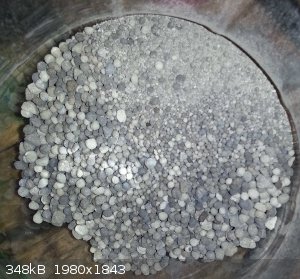RogueRose
International Hazard
    
Posts: 1595
Registered: 16-6-2014
Member Is Offline
|
|
Extracting phosphate's (salts, acids, whatever) from 0-45-0 triple super phosphate
So I wanted to try working with phosphates a little so I obtaines some 0-45-0 triple super phosphate which are prills that are brown and when put in
water it turns to a mud like composition. I heated the solution of 1:1 (200ml water to 200g of phosphate) to try to dissolve any salts and it seemed
to get some of the phosphates to dissolve into the water.
After a couple hours of heating at about 180-190F I poured to filter and allowed to sit overnight and only about 2-3oz filtered through and the liquid
is a green color that looks like mouthwash (could be from stainless steel pan). The undissolved particles in the water, when cooled formed a rock
hard coating on the bottom of the pan about 1/2” thick so it seems that it formed crystals along the bottom layer to make the coating so solid (had
to use chisel & hammer to break up & that was very difficult).
I'm in the process of adding 400ml more of water so a 3:1 ratio, to dissolve more salts, then allow to settle, decant then filter the decanted liquid
& vacuum filter the remaining solids (I'll add about 100-150ml boiling water to solids before filtering).
So since the NPK is 0-45-0, the means there is a good bit of N2O5 and no nitrogen or potassium so IDK what this material is composed of. I'm guessing
the phosphates are in a calcium form such as a calcium phosphate, whether is mono, di or tri calcium phosphate, IDK.
What I am trying to figure out is what can I add to this to extract the phosphates into a more useable and clean form of phosphate. I was thinking of
trying something like sodium or potassium carbonate as they will dissolve nicely in water, then add the phosphate which, if it is calcium based, might
replace the calcium with potassium/sodium (making Na/K phosphates) and leaving CaCO3 as the calcium compound.
I guess the other options would be to use H2SO4 to the phosphate which would make a phosphoric acid and leave a dirty CaSO4 behind as the calcium
compound (and any “mud” that is mixed in with the phosphate mix). Another option I was thinking would be oxalic acid but am unsure how this would
work but it has a solubility of .67mg / liter! So basically insoluble and the CaC2O4 might be much easier to deal with than the CaSO4 as it is SO
fluffy – but IDK if CaC2O4 has any uses (even dirty CaSO4 can be used in some castings for forges and such..).
I'm going to try this again with glass instead of a stainless pot, but I was trying to avoid using this b/c I've had lots of breakage recently and
it's getting costly (even beaker replacement gets up there!)
|
|
|
Vosoryx
Hazard to Others
  
Posts: 282
Registered: 18-6-2017
Location: British Columbia, Canada
Member Is Offline
Mood: Serial Apple Enjoyer
|
|
What exact brand is it?
Just doing a quick google search, I can find two different types.
(HERE)
(AND HERE)
And though they each have the same active ingredient, there are other minor components that differ in each and might get in the way of a proper
extraction.
The point is than unless we (you) know exactly what brand was used, we can't be sure of a proper extraction.
"Open your mind son, before someone opens it for you." - Dr. Walter Bishop
|
|
|
RogueRose
International Hazard
    
Posts: 1595
Registered: 16-6-2014
Member Is Offline
|
|
Quote: Originally posted by Vosoryx  | What exact brand is it?
Just doing a quick google search, I can find two different types.
(HERE)
(AND HERE)
And though they each have the same active ingredient, there are other minor components that differ in each and might get in the way of a proper
extraction.
The point is than unless we (you) know exactly what brand was used, we can't be sure of a proper extraction. |
I see your point, I looked at the MSDS's and there is a difference. Mine is a generic that comes from an Agway distribution location and only lists
P2O5 content. I wonder if there is a way to analyze what it is and see what the composition is.
I've added more water and am boiling it now. I intend to filter off the undissolved solids (which is a good bit), allow to settle, then filter the
liquid and then evaporate. Can you think of anything that is better than doing this?
I was thinking of trying to add H2SO4 and oxalic acid to two different batches, allow to dissolve, decant, filter then evaporate and see what I get.
The problem is that this might just make phosphoric acid instead of any salt. Is phosphoric acid green? I've seen some that is green in color but
didn't know if that was some color added.
|
|
|
RogueRose
International Hazard
    
Posts: 1595
Registered: 16-6-2014
Member Is Offline
|
|
So I got some pics to show what I'm getting from this TSP and I don't think the green color is from the stainless steel pan as I had some after about
5 mins of it being in the pan. I'm trying dissolving some in glass and see if it turns green as well.
This is filtering the "mud" through a cotton filter

What the mud looks like in the funnel

Solids left after fine "mud" is poured off

Original state of the TSP right out of the bag

|
|
|
unionised
International Hazard
    
Posts: 5128
Registered: 1-11-2003
Location: UK
Member Is Offline
Mood: No Mood
|
|
One interesting thing you might be able to extract from it is uranium.
It's present in traces in phosphate ores.
|
|
|